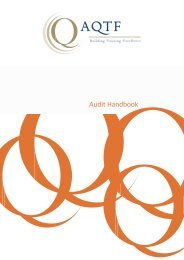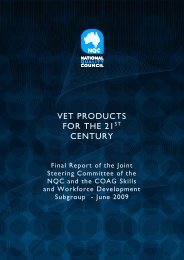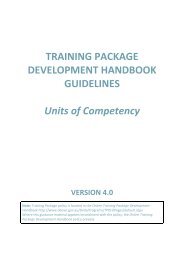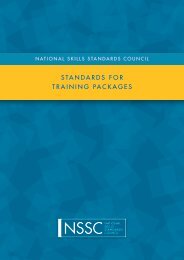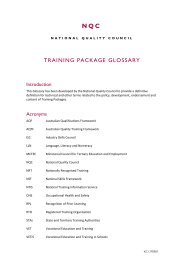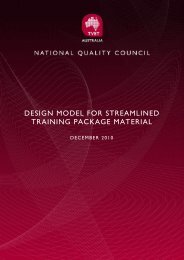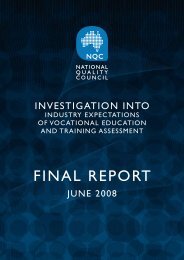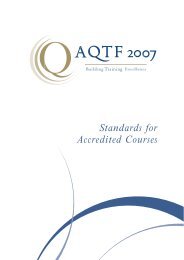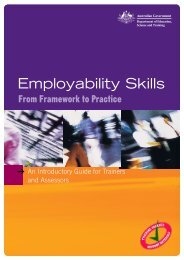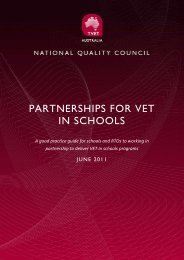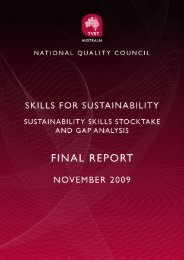Guide for Developing Assessment Tools - National Skills Standards ...
Guide for Developing Assessment Tools - National Skills Standards ...
Guide for Developing Assessment Tools - National Skills Standards ...
- No tags were found...
Create successful ePaper yourself
Turn your PDF publications into a flip-book with our unique Google optimized e-Paper software.
NQC | <strong>Guide</strong> <strong>for</strong> developing assessment toolsTable 1: Ideal Characteristics of an <strong>Assessment</strong> ToolComponentThe contextCompetencyMappingThe in<strong>for</strong>mation tobe provided to thecandidateThe evidence to becollected from thecandidateDecision makingrulesRange andconditionsMaterials/resourcesrequiredAssessorinterventionReasonableadjustments (<strong>for</strong>enhancing fairnessand flexibility)Validity evidenceReliability evidenceRecordingrequirementsReportingrequirementsDescriptionThe target group and purpose of the tool should be described. This should include adescription of the background characteristics of the target group that may impact on thecandidate per<strong>for</strong>mance (e.g. literacy and numeracy requirements, workplaceexperience, age, gender etc).The components of the Unit(s) of Competency that the tool should cover should bedescribed. This could be as simple as a mapping exercise between the components ofthe task (e.g. each structured interview question) and components within a Unit orcluster of Units of Competency. The mapping will help to determine the sufficiency ofthe evidence to be collected. An example of how this can be undertaken has beenprovided in Template A.2 (refer to the Appendix).Outlines the task(s) to be provided to the candidate that will provide the opportunity <strong>for</strong>the candidate to demonstrate the competency. It should prompt them to say, do, writeor create something.Provides in<strong>for</strong>mation on the evidence to be produced by the candidate in response tothe task.The rules to be used to:Check evidence quality (i.e. the rules of evidence);Judge how well the candidate per<strong>for</strong>med according to the standard expected (i.e.the evidence criteria); andSynthesise evidence from multiple sources to make an overall judgement.Outlines any restriction or specific conditions <strong>for</strong> the assessment such as the location,time restrictions, assessor qualifications, currency of evidence (e.g. <strong>for</strong> portfolio basedassessments), amount of supervision required to per<strong>for</strong>m the task (i.e. which mayassist with determining the authenticity of evidence) etc.Describes access to materials, equipment etc that may be required to per<strong>for</strong>m the task.Defines the amount (if any) of support provided.This section should describe the guidelines <strong>for</strong> making reasonable adjustments to theway in which evidence of per<strong>for</strong>mance is gathered (e.g. in terms of the in<strong>for</strong>mation tobe provided to the candidate and the type of evidence to be collected from thecandidate) without altering the expected per<strong>for</strong>mance standards (as outlined in thedecision making rules).Evidence of validity (such as face, construct, predictive, concurrent, consequential andcontent) should be provided to support the use of the assessment evidence <strong>for</strong> thedefined purpose and target group of the tool.If using a per<strong>for</strong>mance based task that requires professional judgement of theassessor, evidence of reliability could include providing evidence of:The level of agreement between two different assessors who have assessed thesame evidence of per<strong>for</strong>mance <strong>for</strong> a particular candidate (i.e. inter-rater reliability);andThe level of agreement of the same assessor who has assessed the sameevidence of per<strong>for</strong>mance of the candidate, but at a different time (i.e. intra-raterreliability).If using objective test items (e.g. multiple choice tests) than other <strong>for</strong>ms of reliabilityshould be considered such as the internal consistency of a test (i.e. internal reliability)as well as the equivalence of two alternative assessment tasks (i.e. parallel <strong>for</strong>ms).The type of in<strong>for</strong>mation that needs to be recorded and how it is to be recorded andstored, including duration.For each key stakeholder, the reporting requirements should be specified and linked tothe purpose of the assessment.GUIDE FOR DEVELOPING ASSESSMENT TOOLS PAGE 7



